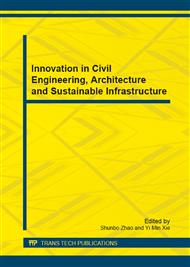[1]
A. T. Houssam, E. Tahar, The influence of silica fume on the compressive strength of cement paste and mortar, Cement and Concrete Research, 25 (1995) 1591-1602.
DOI: 10.1016/0008-8846(95)00152-3
Google Scholar
[2]
A. A. Almusallam, H. Beshr, M. Maslehuddin, O. S. B. Al-Amoudi, Effect of silica fume on the mechanical properties of low quality coarse aggregate concrete, Cement and Concrete Composites. 26 (2004) 891-900.
DOI: 10.1016/j.cemconcomp.2003.09.003
Google Scholar
[3]
S. Bhanja, B. Sengupta, S. K. Kaushik, P. Kumar, Optimum silica fume content and its mode of action on concrete, ACI Materials Journal, 101 (2004) 327-328.
Google Scholar
[4]
M. F. M. Zain, M. Safiuddin, H. Mahmud, Development of high performance concrete using silica fume at relatively high water-binder ratios, Cement and Concrete Research, 30 (2000) 1501-1505.
DOI: 10.1016/s0008-8846(00)00359-8
Google Scholar
[5]
B. G. Smith, Durability of silica fume concrete exposed to chloride in hot climates, J. Mater. Civ. Eng. 13 (2001) 41-48.
DOI: 10.1061/(asce)0899-1561(2001)13:1(41)
Google Scholar
[6]
P. Zhang, Q. Li, H. Zhang, Combined effect of polypropylene fiber and silica fume on mechanical properties of concrete composite containing fly ash, Journal of Reinforced Plastics and Composites, 30 (2011) 1851-1860.
DOI: 10.1177/0731684411425974
Google Scholar
[7]
P. Zhang, Q. Li, Z. Sun, Influence of silica fume and polypropylene fiber on fracture properties of concrete composite containing fly ash, Journal of Reinforced Plastics and Composites, 30 (2011) 1977-(1988).
DOI: 10.1177/0731684411431358
Google Scholar
[8]
P. Zhang, Q. Li, Z. Sun, Effect of polypropylene fibre on flexural properties of concrete composites containing fly ash and silica fume, Proc. Inst. Mech. Eng. Part L, Journal of Materials Research Applications, 226 (2012) 177-181.
DOI: 10.1177/1464420712437637
Google Scholar
[9]
JTJ E30-2005, Test methods of cement and concrete for highway engineering test methods of materials stabilized with inorganic binders for highway engineering, China Communications Press, Beijing, (2005).
Google Scholar
[10]
GB 11974-1997, Test method for carbonation of aerated concrete, Standards Press of China, Beijing, (1997).
Google Scholar


